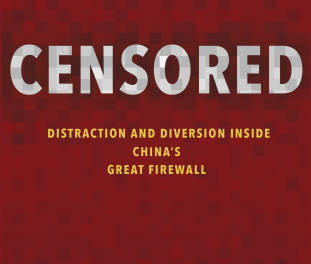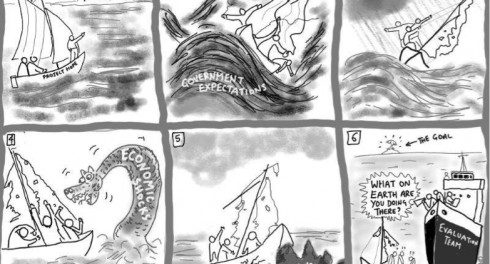
Not every space is so open
The end of 2018 saw dictionaries competing to showcase their words of the year. Most had a resonance for the transparency, accountability and philanthropic communities, be it “toxic”, “misinformation” or “justice,” and as we enter a new year, they got me asking what words or phrases have passed their sell-by-date and that we should avoid in 2019. Top on my list- “Closing civic space.”It might seem an odd choice, given that strengthening “civic space” is one of the Transparency and Accountability Initiative’s four strategic priorities. Why is it problematic? I suggest in part it’s the terminology itself, but also the nature of the conversations it’s sparked. See 3 concerns and some ideas on what to do differently.
1. Let’s start with the term itself.
“Closing civic space” is too all-encompassing. This was useful when trying to mobilize attention to this trend. It risks becoming a hindrance in terms of getting to action.
This was brought home at a Funders Initiative for Civil Society (FICS) gathering last month. Over 50 private funder representatives could not agree on the symptoms of this phenomenon ranging from reduced access to foreign funding for local civil society groups to physical threats to online hacks to concerted attempts to discredit civil society groups (and their funders). Yet it is proving much harder to coalesce on actions to take. In part, this reflects the generic nature of a term that actually covers a great variety of behaviors. It tempts funders to search for a similarly encompassing “solution,” which does not exist. It also hides differing views as to the underlying drivers that most merit a coordinated response. We risk talking past each other when some assume we are really discussing the crisis of democracy, others see this as the excuse to tackle overly dominant corporate power, some assume we are talking about creating emergency funds and some on creating a new paradigm for civic action.
The term also risks being too anodyne, too normalizing. It invites a need for explanation, for diagnosis (the FICS team have flagged 57 donor-funded civic space reports – largely saying the same thing). This has helped ensure the challenge is well noted, but perhaps, not facilitated a sense of urgency. If we referred instead to the “Criminalization of activism” or equivalents would we see more ready action?
2. Bundling a variety of distinct phenomena under an umbrella phrase has not prevented siloed responses.
This is true within individual funders – given its implications for so many programs operating in countries where civil society groups are experiencing new restrictions, appointing a single responsible staff and attempting a standard programmatic response is unlikely to be successful. It is also true across groups of funders. There are notable efforts to forge collective responses, such as FICS, but the private funders and government funders are having similar but parallel conversations. TAI is one of the few, if not only, platforms I’m aware of that has members spanning both tracks.
3. The term risks being hijacked.
It is striking that those convening around “closing civic space” are almost exclusively progressive funders. Where are those on more conservative side of the spectrum, who might also care about protection of independent media, for example? Are they having parallel conversations? Do we risk the term conveying an ideological edge that prevents potential allies joining in to take action?
This concern extends to labeling of those affected. It has been striking how many conversations on closing civic space default to talking about human rights defenders at risk. Yes, they are very much at the frontlines, but they are not alone there. Transparency and anti-corruption activists are being targeted (see the findings of TAI’s member grantee survey). Environmental campaigners are finding their ability to operate hampered. The list goes on. If we see this term appropriated by the human rights community alone, we risk unnecessary segmentation of effort both among activists on the ground and among the funding community.
So what to do?
1. Let’s break this out into the specific issues at play.
Let’s get the right mix of players in the room to ask how best to help civil society groups manage digital threats. Let’s not assume that those same people are also the ones to talk about support for emergency protections/evacuations for activists, or to design approaches to develop successful counter-narratives. Where we are seeing more galvanized funder responses is where there is a specific focus – be that a specific geography, specific issue, or both.
2. Let’s bridge learnings across what is being tried.
Ideally, we would prioritize spaces for civil society groups themselves to design responses, but more can be done among funders, too. For example, both USAID and DFID are inviting and funding consortia responses to “closing civic space.” How do we ensure private foundations can learn from that? (Especially as they are also funding many some of successfully bidding groups). What mechanism is there to assess and compare how useful emergency support funds really are? Kudos to the International Consortium on Closing Civic Space for compiling real-world case examples/learnings (e.g. Mexico, Poland, Tunisia).
3. Stop playing on the edges.
Why not take one manifestation of closing space and assemble the ideas and responses to tackle it meaningfully? For example, we know a host of groups are facing digital threats, yet experts estimate there is just $4m of dedicated digital rights funding in Europe (and that is well resourced compared to most regions). Why is there no $100 million collective effort to protect digital rights wherever they are under attack? Why not the same for independent media? International funding cannot be the sole solution on that front, but there is certainly scope for more support and to incentivize local funding in parallel.
Even if none of that appeals – funders can at the very least get the basics right i.e. support local civil society groups, offer flexible funding where possible, fund experiments to diversify constituencies of support. This can be done within existing grant structures. From there, we might layer the ambition back on, but around specific problems, target geographies and with an eye to measuring effectiveness. Yes, fund spaces for affected groups to compare notes and jointly strategize around those specific entry points, but we don’t need more generic conversations (certainly not among funders). We are past the point of diagnostics and handwringing. Time for action in 2019.
This blog was written by Michael Jarvis (Executive Director at TAI).


